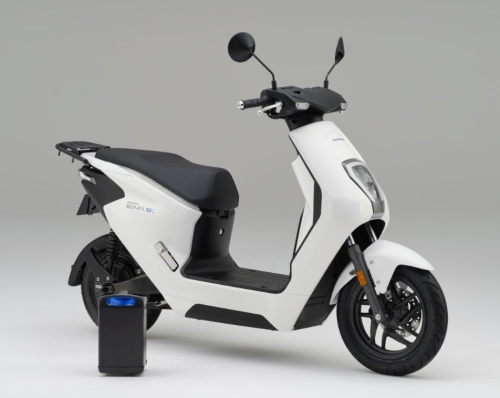Europe Electric Two-Wheeler market size was USD 11.17 billion in 2023 and the market is projected to touch USD 31.33 billion by 2032, at a CAGR of 12.14 % during the forecast period. Electric two-wheeler vehicles are powered by electric motors and rechargeable batteries, offering a more sustainable alternative to traditional gas-powered vehicles. With their environmentally friendly design, affordability, and convenience, electric two-wheelers are becoming increasingly popular in urban areas where traffic and pollution are major issues. In the European market for electric two-wheelers, there is a growing demand for eco-friendly options like electric scooters, motorcycles, and bicycles. European countries are working towards sustainability goals and cutting greenhouse gas emissions, leading to a projected surge in the demand for electric two-wheelers in the near future.
The European electric two-wheeler market is expanding due to increasing awareness of environmental issues and the importance of sustainable transportation options. Governments in Europe are enacting regulations and offering incentives like subsidies and tax breaks to promote the use of electric vehicles. Consumers are also becoming more environmentally conscious, opting for greener transportation choices for their daily commute and short trips. This has led to an increase in production of electric scooters, motorcycles, and bicycles to meet the rising demand. Due to improvements in battery technology, electric motorcycles and scooters are now more cost-effective, can travel longer distances, and provide superior performance. This makes them a more appealing choice for individuals seeking a greener and more eco-friendly means of getting around.
Europe Electric Two-Wheeler report scope and segmentation.
| Report Attribute | Details |
| Base Year | 2023 |
| Forecast Years | 2024 – 2032 |
| Estimated Market Value (2023) | USD 11.17 Billion |
| Projected Market Value (2032) | USD 31.33 Billion |
| Segments Covered | By Product Type, By Voltage, By Power, By Battery Type, By Battery Technology, By Battery Current, & By Region. |
| Forecast Units | Value (USD Million or Billion) |
| Quantitative Units | Revenue in USD million/billion and CAGR from 2024 to 2032. |
| Regions Covered | Europe |
| Countries Covered | U.K., Germany, France, Italy, Spain and Rest of Europe |
Europe Electric Two-Wheeler dynamics
The electric two-wheeler market in Europe is constantly changing due to different factors. One important factor is the increasing awareness of environmental sustainability and the importance of reducing carbon emissions. Governments are also introducing stringent regulations to address pollution and encourage cleaner transportation options, which is driving up the demand for electric two-wheelers. Additionally, the trend towards urbanization and the congestion in major cities are leading to an increased interest in electric scooters and bicycles as convenient and efficient modes of transportation for short distances.
Technology is really important regarding how electric scooters are doing in Europe. Better batteries, like high-performance lithium-ion ones, have made electric scooters go farther, be more efficient, and charge up quicker. Plus, adding smart features like GPS, mobile apps, and remote diagnostics makes electric scooters even more attractive to different types of people. As manufacturers invest more in research and development, market can anticipate more progress in electric vehicle technology. This will drive continued growth and innovation in the European electric two-wheeler market.
Europe Electric Two-Wheeler drivers
Government Incentives and Regulations
Governments in Europe are giving more and more encouragement for people to switch to electric two-wheelers by offering subsidies, tax breaks, and other financial incentives. They are also implementing stringent regulations to decrease carbon emissions, which is pushing both consumers and businesses to switch to cleaner forms of transportation. In countries like France and Germany, there are significant subsidies available for those looking to purchase electric vehicles, making them more accessible to a wider range of people. Moreover, efforts to enhance infrastructure, like expanding charging networks, are making it easier for people to adopt electric vehicles.
Environmental Awareness and Sustainability Goals
Consumers in Europe are increasingly environmentally conscious, leading to a growing demand for electric two-wheelers. People are recognizing the negative impact of traditional gasoline vehicles on the environment, prompting a move towards more eco-friendly options. Electric two-wheelers provide a cleaner mode of transportation with no emissions, making them a preferred choice for those who care about the planet. Additionally, the European Union’s goals for sustainability, such as aiming for carbon neutrality by 2050, are driving the adoption of sustainable transportation solutions and boosting the electric two-wheeler market.
- Restraints:
High Initial Cost
The main obstacle to people choosing electric two-wheelers is their higher initial price compared to traditional gasoline vehicles. Even with government assistance, electric two-wheelers tend to be more expensive because of the technology and components involved. This can discourage cost-conscious consumers from making the switch to electric vehicles, especially in areas where people have limited buying power.
Charging Infrastructure Challenges
The limited availability of charging stations is a major obstacle to the widespread use of electric two-wheelers in Europe. Although there are initiatives to increase the number of charging points in cities, the lack of stations in rural areas is still a concern. Range anxiety, which is the fear of running out of battery power without a nearby charging option, is a significant issue for potential electric vehicle customers and hinders market expansion.
- Opportunities:
Urban Mobility Solutions
The rise in city populations and traffic in Europe has made electric two-wheelers a promising solution for transportation challenges. These compact vehicles provide a flexible and efficient way to travel short distances, especially in crowded urban areas. By encouraging the use of electric scooters and bikes instead of cars, cities can decrease congestion, pollution, and noise, while enhancing urban accessibility and mobility.
- Segment Overview
By product type, the electric two-wheeler market is segmented into E-Motorcycles, E-Bikes, and E-Scooters. E-Motorcycles are electrically powered motorcycles designed to offer comparable performance to their gasoline-powered counterparts. They typically feature larger battery capacities and higher power outputs, making them suitable for longer commutes and highway riding. E-Bikes, on the other hand, are electrically assisted bicycles equipped with electric motors that provide propulsion assistance to the rider. Bikes that have electric assistance are gaining popularity for leisure rides, commuting, and outdoor activities. They offer an eco-friendly option compared to regular bikes. E-Scooters, or electric mopeds, are small and light electric vehicles made for short urban commutes. They are easy to handle in busy city streets and are perfect for quick trips to work or school. E-Scooters usually have smaller batteries and less power than E-Motorcycles, focusing on being portable and efficient for city travel.
By Voltage, the electric two-wheelers market is segmented into 48V, 60V, and 72V and above. Electric vehicles with higher voltage systems generally offer higher performance, longer range, and faster charging times compared to those with lower voltage systems. A 48V electric two-wheeler is typically more lightweight and affordable, making it suitable for urban commuting and short-distance travel. Electric two-wheelers, those equipped with 60V or higher voltage systems can reach faster speeds and travel longer distances on just one charge. This makes them perfect for longer trips and highway journeys. These higher voltage electric vehicles also have stronger motors and advanced battery management systems to improve performance and efficiency. However, they could be more expensive because of the added complexity of their electrical systems and components.
Europe Electric Two-Wheeler Overview by Region
The electric two-wheeler market in Europe is influenced by various factors such as government policies, infrastructure development, consumer preferences, and economic conditions, leading to significant regional dynamics. Western European countries like Germany, France, and the Netherlands are at the forefront of the market due to strong governmental support, well-established charging infrastructure, and high environmental awareness among consumers. These countries provide subsidies and incentives to promote the adoption of electric vehicles, resulting in substantial market growth. Furthermore, the market in Western Europe is driven by the presence of reputable manufacturers and new start-ups. On the other hand, Eastern European countries are seeing slower growth due to lower purchasing power, limited infrastructure, and weaker government support. Even with this, as environmental awareness increases and economic conditions improve, Eastern European markets are starting to show promise for future expansion.
Europe Electric Two-Wheeler market competitive landscape
Established manufacturers such as Vespa, BMW, and Piaggio are leveraging their brand recognition and expertise in traditional two-wheeler manufacturing to introduce electric models and expand their presence in the market. Additionally, innovative startups like NIU, Etergo, and Gogoro are disrupting the industry with cutting-edge technology, sleek designs, and innovative business models. Start-ups in the electric vehicle industry are targeting specific markets like city commuters and delivery services. They are incorporating unique features such as interchangeable batteries and connectivity options to set themselves apart from established automakers. Collaboration between EV manufacturers and tech firms is on the rise to innovate products and create new mobility solutions. Collaborative efforts among governments, academic institutions, and industry stakeholders are spurring innovation and encouraging the use of electric bicycles and scooters. These partnerships focus on tackling obstacles like building charging stations, establishing standards, and creating regulations, all of which support the growth of the market.
Europe Electric Two-Wheeler Recent Developments
- Nov 2023, Hero MotoCorp, the world’s leading two-wheeler manufacturer, announced its entry into the European market with its electric scooter range slated for launch next year. The company plans to introduce the VIDA V1 electric scooter line in Spain, France, and the UK by mid-2024.
- July 2022, Hindustan Motors (HM), known for the iconic ‘Ambassador’ cars, anticipates establishing a new joint venture with a European counterpart to produce electric two-wheelers by the following year, as stated by a senior official. The project is set to undergo two additional quarters before commencing the pilot phase, with the final product projected for launch by the end of the subsequent fiscal year.
- June 2022, GOVECS unveiled GOVECS Fleet, a fleet management system tailored for sharing services, facilitating swift deployment, expansion, and optimization of new mobility services. The user app, available as a white-label solution, offers a user-friendly and mobile-centric experience. GOVECS Fleet is adaptable for various scooter fleets, catering to diverse operational needs.
Scope of Europe Electric Two-Wheeler report
Europe Electric Two-Wheeler report segmentation
| ATTRIBUTE | DETAILS |
| By Product Type | E-MotorcycleE-BikeE-Scooter |
| By Voltage | 48 V60 V72 V and Above |
| By Power | <5KW6-15KW15KW |
| By Battery Type | Nickel Metal HybridLithium-Ion BatteryLead Acid Batteries |
| By Battery Technology | Non-Removable BatteryRemovable Battery |
| By Battery Current | <25Ah Battery25Ah Battery |
| Customization Scope | Available upon request |
| Pricing | Available upon request |
Frequently Asked Questions (FAQ)
- What is the study period of Europe Electric Two-Wheeler report?
- Europe Electric Two-Wheeler forecast period is 2024 – 2032
- What is the expected Europe Electric Two-Wheeler growth rate during the forecast period?
- According to Europe Electric Two-Wheeler research, the market is expected to grow at a CAGR of ~ 12.14% over the next eight years.
- What is the expected market size for Europe Electric Two-Wheeler?
- The expected market size for Europe Electric Two-Wheeler is USD 31.33 billion in 2032.
- What are the possible segments in Europe Electric Two-Wheeler?
- The possible segments in Europe Electric Two-Wheeler are based on By Product Type, By Voltage, By Power, By Battery Type, By Battery Technology, By Battery Current, & by region.
- Who are the key players in Europe Electric Two-Wheeler?
- The major players in the market are Vespa Ltd, BMW Inc, Piaggio Ltd, NIU Inc, Etergo Ltd, Gogoro Inc, Yamaha Ltd, Energica Inc, Harley-Davidson Ltd, and KTM Inc.
Table of Contents
- Market Scope and Research Methodology
- Market Segmentation & Scope
- Market Definition
- Research Methodology
- Our Internal Database
- Paid Sources Database
- Secondary Sources & Third-Party Perspectives
- Primary Research, Experts Interviews and Market Surveys
- Research Objective
- Data Validation & Publishing
- Executive Summary
- Market Outlook
- Segmental Analysis
- Europe Electric Two-Wheeler Market Dynamics
- Market IntroductionMarket Drivers
- Government Incentives and RegulationsEnvironmental Awareness and Sustainability Goals
- High Initial CostCharging Infrastructure Challenges
- Market Strategic Analysis
- Industry Analysis – Porter’s
- Supplier Power
- Buyer Power
- Substitution Threat
- Threat from New Entrant
- Competitive Rivalry
- PESTEL Analysis
- Consumer behaviour analysis
- Consumer response to the product
- Factors affecting buying decision
- Other recommendations
- Industry Analysis – Porter’s
- Market IntroductionMarket Drivers
- Europe Electric Two-Wheeler Market: Product Type Estimates & Trend Analysis
- Product Type Movement Analysis & Market Share, 2023 & 2032
- E-Motorcycle
- Market estimates and forecast, 2024-2032, (USD Billion)
- E-Bike
- Market estimates and forecast, 2024-2032, (USD Billion)
- E-Scooter
- Market estimates and forecast, 2024-2032, (USD Billion)
- Europe Electric Two-Wheeler Market: Voltage Estimates & Trend Analysis
- Voltage Movement Analysis & Market Share, 2023 & 2032
- 48 V
- Market estimates and forecast, 2024-2032, (USD Billion)
- 60 V
- Market estimates and forecast, 2024-2032, (USD Billion)
- 72 V and Above
- Market estimates and forecast, 2024-2032, (USD Billion)
- Europe Electric Two-Wheeler Market: Power Estimates & Trend Analysis
- Power Movement Analysis & Market Share, 2023 & 2032
- <5KW
- Market estimates and forecast, 2024-2032, (USD Billion)
- 6-15KW
- Market estimates and forecast, 2024-2032, (USD Billion)
- 15KW
- Market estimates and forecast, 2024-2032, (USD Billion)
- Europe Electric Two-Wheeler Market: Battery Type Estimates & Trend Analysis
- Battery Type Movement Analysis & Market Share, 2023 & 2032
- Nickel Metal Hybrid
- Market estimates and forecast, 2024-2032, (USD Billion)
- Lithium-Ion Battery
- Market estimates and forecast, 2024-2032, (USD Billion)
- Lead Acid Batteries
- Market estimates and forecast, 2024-2032, (USD Billion)
- Europe Electric Two-Wheeler Market: Battery Technology Estimates & Trend Analysis
- Battery Technology Movement Analysis & Market Share, 2023 & 2032
- Non-Removable Battery
- Market estimates and forecast, 2024-2032, (USD Billion)
- Removable Battery
- Market estimates and forecast, 2024-2032, (USD Billion)
- Europe Electric Two-Wheeler Market: Battery Current Estimates & Trend Analysis
- Battery Current Movement Analysis & Market Share, 2023 & 2032
- <25Ah Battery
- Market estimates and forecast, 2024-2032, (USD Billion)
- 25Ah Battery
- Market estimates and forecast, 2024-2032, (USD Billion)
- Europe Electric Two-Wheeler Market: Regional Estimates & Trend Analysis
- Regional Movement Analysis & Market Share, 2023 & 2032
- Europe
- Market estimates and forecast, 2024-2032, (USD Billion)
- Market estimates and forecast, by Product Type, 2024-2032, (USD Billion)
- Market estimates and forecast, by Voltage, 2024-2032, (USD Billion)
- Market estimates and forecast, by Power, 2024-2032, (USD Billion)
- Market estimates and forecast, by Battery Type, 2024-2032, (USD Billion)
- Market estimates and forecast, by Battery Technology, 2024-2032, (USD Billion)
- Market estimates and forecast, by Battery Current, 2024-2032, (USD Billion)
- Germany
- Market estimates and forecast, 2024-2032, (USD Billion)
- Market estimates and forecast, by Product Type, 2024-2032, (USD Billion)
- Market estimates and forecast, by Voltage, 2024-2032, (USD Billion)
- Market estimates and forecast, by Power, 2024-2032, (USD Billion)
- Market estimates and forecast, by Battery Type, 2024-2032, (USD Billion)
- Market estimates and forecast, by Battery Technology, 2024-2032, (USD Billion)
- Market estimates and forecast, by Battery Current, 2024-2032, (USD Billion)
- UK
- Market estimates and forecast, 2024-2032, (USD Billion)
- Market estimates and forecast, by Product Type, 2024-2032, (USD Billion)
- Market estimates and forecast, by Voltage, 2024-2032, (USD Billion)
- Market estimates and forecast, by Power, 2024-2032, (USD Billion)
- Market estimates and forecast, by Battery Type, 2024-2032, (USD Billion)
- Market estimates and forecast, by Battery Technology, 2024-2032, (USD Billion)
- Market estimates and forecast, by Battery Current, 2024-2032, (USD Billion)
- Spain
- Market estimates and forecast, 2024-2032, (USD Billion)
- Market estimates and forecast, by Product Type, 2024-2032, (USD Billion)
- Market estimates and forecast, by Voltage, 2024-2032, (USD Billion)
- Market estimates and forecast, by Power, 2024-2032, (USD Billion)
- Market estimates and forecast, by Battery Type, 2024-2032, (USD Billion)
- Market estimates and forecast, by Battery Technology, 2024-2032, (USD Billion)
- Market estimates and forecast, by Battery Current, 2024-2032, (USD Billion)
- France
- Market estimates and forecast, 2024-2032, (USD Billion)
- Market estimates and forecast, by Product Type, 2024-2032, (USD Billion)
- Market estimates and forecast, by Voltage, 2024-2032, (USD Billion)
- Market estimates and forecast, by Power, 2024-2032, (USD Billion)
- Market estimates and forecast, by Battery Type, 2024-2032, (USD Billion)
- Market estimates and forecast, by Battery Technology, 2024-2032, (USD Billion)
- Market estimates and forecast, by Battery Current, 2024-2032, (USD Billion)
- Italy
- Market estimates and forecast, 2024-2032, (USD Billion)
- Market estimates and forecast, by Product Type, 2024-2032, (USD Billion)
- Market estimates and forecast, by Voltage, 2024-2032, (USD Billion)
- Market estimates and forecast, by Power, 2024-2032, (USD Billion)
- Market estimates and forecast, by Battery Type, 2024-2032, (USD Billion)
- Market estimates and forecast, by Battery Technology, 2024-2032, (USD Billion)
- Market estimates and forecast, by Battery Current, 2024-2032, (USD Billion)
- Rest of Europe
- Market estimates and forecast, 2024-2032, (USD Billion)
- Market estimates and forecast, by Product Type, 2024-2032, (USD Billion)
- Market estimates and forecast, by Voltage, 2024-2032, (USD Billion)
- Market estimates and forecast, by Power, 2024-2032, (USD Billion)
- Market estimates and forecast, by Battery Type, 2024-2032, (USD Billion)
- Market estimates and forecast, by Battery Technology, 2024-2032, (USD Billion)
- Market estimates and forecast, by Battery Current, 2024-2032, (USD Billion)
- Competitive Analysis
- Key regional players, recent developments & their impact on the industry
- Key Company/Competition Categorization (Key innovators, Market leaders, Emerging players)
- Vendor Landscape
- Key company market share analysis, 2021
- Company Profiles
- Vespa Ltd.
- Company Overview
- Financial Analysis
- Product Benchmarking
- Key development
- Business Strategy
- SWOT Analysis
- BMW Inc.
- Company Overview
- Financial Analysis
- Product Benchmarking
- Key development
- Business Strategy
- SWOT Analysis
- KTM Inc.
- Company Overview
- Financial Analysis
- Product Benchmarking
- Key development
- Business Strategy
- SWOT Analysis
- Piaggio Ltd.
- Company Overview
- Financial Analysis
- Product Benchmarking
- Key development
- Business Strategy
- SWOT Analysis
- NIU Inc.
- Company Overview
- Financial Analysis
- Product Benchmarking
- Key development
- Business Strategy
- SWOT Analysis
- Etergo Ltd.
- Company Overview
- Financial Analysis
- Product Benchmarking
- Key development
- Business Strategy
- SWOT Analysis
- Gogoro Inc.
- Company Overview
- Financial Analysis
- Product Benchmarking
- Key development
- Business Strategy
- SWOT Analysis
- Yamaha Ltd.
- Company Overview
- Financial Analysis
- Product Benchmarking
- Key development
- Business Strategy
- SWOT Analysis
- Energica Inc.
- Company Overview
- Financial Analysis
- Product Benchmarking
- Key development
- Business Strategy
- SWOT Analysis
- Harley-Davidson Ltd.
- Company Overview
- Financial Analysis
- Product Benchmarking
- Key development
- Business Strategy
- SWOT Analysis
- Vespa Ltd.











